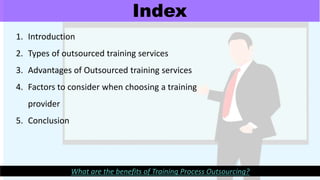

Ensuring proper training for outsourced employees is a significant challenge in today’s globalized business environment. Outsourced teams are an increasingly important part of many organizations’ operations, but their training often falls short of internal employee standards. This often leads to decreased productivity, increased error rates, and ultimately, a negative impact on the organization’s bottom line. This article explores the challenges of effective training for outsourced employees and outlines practical strategies to overcome them. The structure of this article includes defining the challenge, examining different approaches to training, focusing on practical strategies, and offering a conclusion.
Defining the Challenge of Outsourced Employee Training
Understanding the Complexity of External Training
Many organizations rely on outsourced employees to handle critical tasks and projects. This reliance often comes with the assumption that training will take place, but the reality is complex. It’s crucial to understand that training outsourced employees often requires different methods and approaches than those used for internal teams. This often involves navigating geographical differences, cultural nuances, and varied skill sets. The effectiveness of a training program often hinges on the quality of communication and collaboration between the training provider and the outsourced team. Effective training needs to consider time zones and scheduling constraints, and it must also account for different learning styles and preferences among the dispersed employees.
Common Challenges Faced
Many organizations struggle to ensure consistency and quality in the training provided to outsourced employees. One major challenge is a lack of clear communication between internal departments and external training providers. This can result in inconsistent messages and a lack of engagement from the outsourced employees. Another hurdle involves ensuring the training materials are relevant and up-to-date, which is especially vital in rapidly evolving industries. Cultural differences can also create communication barriers and challenges in delivering impactful training. Finding and sustaining qualified trainers or instructors for outsourced employees can also be a significant hurdle. This can especially be challenging in remote or geographically dispersed situations.
Identifying Practical Solutions
This article will cover the practical solutions for effectively training outsourced employees, providing guidance and actionable strategies for organizations to address the challenges of ensuring proper training.
Developing a Comprehensive Training Strategy
Creating a Standardized Training Program
A standardized training program is essential for ensuring consistency and quality in training for outsourced employees. This includes creating detailed training materials, setting clear learning objectives, and establishing a measurable assessment process. A critical element is involving outsourced employees in the design process. Understanding their specific needs and challenges can significantly improve the effectiveness of training programs.
Utilizing Effective Training Platforms
There are various online training platforms available that can be used to deliver training to outsourced employees, regardless of their location. These platforms often offer features for tracking progress, providing feedback, and allowing for interactions between trainers and trainees. Utilizing online learning platforms, such as platforms in LMS (learning management systems) also allows for scalability, flexibility and cost-effective delivery of training programs to geographically dispersed teams.
Tailoring Training to Specific Roles and Skills
It is crucial to recognize that outsourced employees often fulfill diverse roles and require various skill sets. Training programs should be tailored to address the specific needs of each role, ensuring employees have the necessary knowledge and skills to perform their duties effectively. The program should also cover specific industry-related or company-specific information relevant to their tasks.
Establishing Clear Communication Channels
Building Trust and Rapport with External Teams
Open communication is essential for successful training initiatives. Organizations should establish clear communication channels between internal staff and outsourced employees, allowing for questions, feedback, and two-way communication. Establishing regular check-ins and feedback sessions can foster a strong sense of collaboration and shared responsibility.
Utilizing Technology for Effective Communication
Implementing tools for efficient communication—such as video conferencing, instant messaging, or dedicated project management platforms—facilitates communication across geographical boundaries. These tools also help streamline training delivery and enable consistent follow-up. Clear communication and information sharing are key to the success of any training initiative.
Providing Regular Feedback and Support
Organizations should establish regular feedback mechanisms to track the progress of outsourced employees and identify areas that need improvement. Providing ongoing support and resources to the outsourced staff will not only increase their skills and knowledge but will also improve their sense of belonging and confidence in the job. Regularly scheduling check-ins and feedback sessions provides critical opportunities for identifying and addressing any challenges or concerns the outsourced employees may have.
Measuring Training Effectiveness
Establishing Clear Performance Metrics
Measuring the effectiveness of training programs for outsourced employees is vital for continuous improvement. Setting clear performance metrics enables organizations to track progress and identify areas where training needs to be adjusted. It also allows the assessment of the overall impact of the training and identify successful training strategies.
Analyzing Training Data and Feedback
Detailed analysis of training data—such as completion rates, feedback, and performance indicators—provides insights into the effectiveness of training programs. Identifying trends and patterns in the data allows for adjustments and improvements in training materials and methodologies. Collecting and analyzing this data helps pinpoint potential weaknesses or areas where training should be focused.
Adapting the Program based on Data Analysis
Training programs should not be static. Continuous monitoring and evaluation of the program’s effectiveness through performance metrics are vital. Data analysis should guide decisions on program adjustments to ensure ongoing alignment with changing business needs and employee skill development needs. Regular reviews and necessary adjustments to the program improve its effectiveness and relevancy in the long run.
Ensuring Compliance and Consistency
Implementing Compliance Training Modules
Training for outsourced employees should cover relevant compliance regulations and industry standards. This may include data security, legal, or safety guidelines. This ensures the outsourced employees are well-versed with necessary protocols to avoid any violations or incidents that could impact the company’s reputation.
Maintaining Standards for All Outsourced Teams
Enforcing standardized protocols and practices across all outsourced teams is vital for maintaining consistency and maintaining a unified brand image. This aspect ensures uniform implementation of company policies and guidelines across various project teams and departments, fostering a unified work environment. This standardization will ensure continuity in quality and performance across all outsourced teams, maintaining brand identity and consistency in services.
Creating a Support Structure for Continuous Learning
Organizations should establish continuous support mechanisms, such as knowledge bases, FAQs, or online communities, to reinforce the training received by outsourced employees. This facilitates continuous learning, and fosters a supportive and engaging training culture that encourages development and improvement for all outsourced team members.
In conclusion, ensuring proper training for outsourced employees is crucial for success. By implementing robust training programs, clear communication channels, and ongoing performance management, organizations can maximize the productivity and efficiency of their outsourced workforce. Next steps for organizations include evaluating current training practices, developing a comprehensive training strategy, and providing ongoing support and resources to outsourced employees. Contact us today to learn more about how our team can assist you with your outsourced employee training.